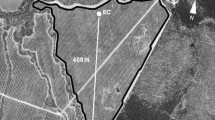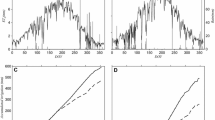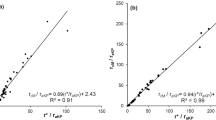Abstract
The degree of coupling between canopy and atmosphere, through the decoupling factor Ω, well describes the behaviour of a crop concerning its water use and carbon dioxide exchange. Super high-density hedgerow olive orchard system is in great expansion all over the world and, since it has a complex field structure in rows of adjacent trees, investigations are necessary to assess the Ω patterns, as well as aerodynamic (ga) and canopy (gc) conductances in different water conditions. In this study, in a hedgerow olive orchard (cv. “Arbosana”) submitted to full (FI) and regulated deficit irrigation (RDI), cropped under a Mediterranean semi-arid climate (southern Italy), Ω has been determined using gc, as deduced by inverting the Penman-Monteith equation, and ga, by upscaling the wind speed measured in a close station to the canopy; the transpiration has been measured by sap flow thermal dissipation method. The results showed that this olive orchard results very well coupled to the atmosphere, in any soil water conditions; Ω is generally very low, being during daytime equal in mean to 0.021±0.003 ms-1 and 0.018±0.004 ms-1 for RDI and FI, respectively. This condition is linked to ga and gc values; in fact, canopy conductance is much smaller than the aerodynamic one in any water and climatic conditions, except when all canopy surfaces are saturated in water. In this latter case, the gc assumes the highest values due to the contribution of the part of conductance attributable to the structure of the orchard.











Similar content being viewed by others
Data availability
Data are available under request to the authors. Pictures and description of used equipment are available under request.
References
Alfieri JG, Kustas WP, Nieto H et al (2019) Influence of wind direction on the surface roughness of vineyards. Irrig Sci 37:359–373. https://doi.org/10.1007/s00271-018-0610-z
Baldocchi DD, Luxmoore RJ, Hatfield JL (1991) Discerning the forest from the trees: an essay on scaling canopy stomatal conductance. Agric For Meteorol 54:197–226. https://doi.org/10.1016/0168-1923(91)90006-C
Bonachela S, Orgaz F, Villalobos FJ, Fereres E (2001) Soil evaporation from drip-irrigated olive orchards. Irrig Sci 20:65–71. https://doi.org/10.1007/s002710000030
Bréda N, Granier A, Barataud F, Moyne C (1995) Soil water dynamics in an oak stand. Plant Soil 172:17–27. https://doi.org/10.1007/BF00020856
Brito C, Dinis L-T, Ferreira H et al (2018) The role of nighttime water balance on Olea europaea plants subjected to contrasting water regimes. J Plant Physiol 226:56–63. https://doi.org/10.1016/j.jplph.2018.04.004
Campi P, Gaeta L, Mastrorilli M, Losciale P (2020) Innovative Soil Management and Micro-Climate Modulation for Saving Water in Peach Orchards. Front Plant Sci 11. https://doi.org/10.3389/fpls.2020.01052
Campi P, Mastrorilli M, Stellacci AM et al (2019) Increasing the effective use of water in green asparagus through deficit irrigation strategies. Agric Water Manag 217:119–130. https://doi.org/10.1016/j.agwat.2019.02.039
Camposeo S, Godini A (2010) Preliminary observations about the performance of 13 varieties according to the super high density olive culture training system in Apulia (southern Italy). Adv Hortic Sci 24:16–20
Chebbi W, Boulet G, le Dantec V et al (2018) Analysis of evapotranspiration components of a rainfed olive orchard during three contrasting years in a semi-arid climate. Agric For Meteorol 256–257:159–178. https://doi.org/10.1016/j.agrformet.2018.02.020
Daudet FA, le Roux X, Sinoquet H, Adam B (1999) Wind speed and leaf boundary layer conductance variation within tree crown. Agric For Meteorol 97:171–185. https://doi.org/10.1016/S0168-1923(99)00079-9
Daudet FA, Perrier A (1968) Etude de l’evaporation ou de la condensation a la surface d’un corps, a partir du bilan energetique
de Kauwe MG, Medlyn BE, Knauer J, Williams CA (2017) Ideas and perspectives: how coupled is the vegetation to the boundary layer? Biogeosciences 14:4435–4453. https://doi.org/10.5194/bg-14-4435-2017
Egea G, Diaz-Espejo A, Fernández JE (2016) Soil moisture dynamics in a hedgerow olive orchard under well-watered and deficit irrigation regimes: Assessment, prediction and scenario analysis. Agric Water Manag 164:197–211. https://doi.org/10.1016/j.agwat.2015.10.034
Fernández J-E (2014) Understanding olive adaptation to abiotic stresses as a tool to increase crop performance. Environ Exp Bot 103:158–179. https://doi.org/10.1016/j.envexpbot.2013.12.003
Fernández JE, Díaz-Espejo A, Infante JM et al (2006) Water relations and gas exchange in olive trees under regulated deficit irrigation and partial rootzone drying. Plant and Soil 284:273–291. https://doi.org/10.1007/s11104-006-0045-9
Fernández JE, Moreno F, Girón IF, Blázquez OM (1997) Stomatal control of water use in olive tree leaves. Plant and Soil 190:179–192. https://doi.org/10.1023/A:1004293026973
Fernández JE, Perez-Martin A, Torres-Ruiz JM et al (2013) A regulated deficit irrigation strategy for hedgerow olive orchards with high plant density. Plant and Soil 372:279–295
Forster MA, Kim TDH, Kunz S et al (2022) Phenology and canopy conductance limit the accuracy of 20 evapotranspiration models in predicting transpiration. Agric For Meteorol 315:108824. https://doi.org/10.1016/j.agrformet.2022.108824
Godini A, Vivaldi GA, Camposeo S (2011) Olive cultivars field-tested in super-high-density system in southern Italy. Calif Agric (Berkeley) 65:39–40. https://doi.org/10.3733/ca.v065n01p39
Granier A (1985) Une nouvelle methode pur la mesure du flux de seve brute dans le tronc des arbres (A new method of sap flow mensurement in tree stems). Annales des Sciences Forestières 42(2): 193–200 (in French)
Granier A (1987) Evaluation of transpiration in a Douglas-fir stand by means of sap flow measurements. Tree Physiol 3:309–320. https://doi.org/10.1093/treephys/3.4.309
Grossiord C, Forner A, Gessler A et al (2015) Influence of species interactions on transpiration of Mediterranean tree species during a summer drought. Eur J For Res 134:365–376. https://doi.org/10.1007/s10342-014-0857-8
Iniesta F, Testi L, Orgaz F, Villalobos FJ (2009) The effects of regulated and continuous deficit irrigation on the water use, growth and yield of olive trees. Eur J Agron 30:258–265. https://doi.org/10.1016/j.eja.2008.12.004
Jarvis PG, McNaughton KG (1986) Stomatal Control of Transpiration: Scaling Up from Leaf to Region. pp 1–49
Katerji N, Rana G (2011) Crop Reference Evapotranspiration: A Discussion of the Concept, Analysis of the Process and Validation. Water Resources Management 25:1581–1600. https://doi.org/10.1007/s11269-010-9762-1
Katerji N, Rana G, Ferrara RM (2017) Actual evapotranspiration for a reference crop within measured and future changing climate periods in the Mediterranean region. Theor Appl Climatol 129:923–938. https://doi.org/10.1007/s00704-016-1826-6
Kjelgaard JF, Stockle CO (2001) Evaluating surface resistance for estimating corn and potato evapotranspiration with the Penman–Monteith model. Transactions of the ASAE 44:797
Köstner BMM, Schulze E-D, Kelliher FM et al (1992) Transpiration and canopy conductance in a pristine broad-leaved forest of Nothofagus: an analysis of xylem sap flow and eddy correlation measurements. Oecologia 91:350–359. https://doi.org/10.1007/BF00317623
Lee X, Massman W, Law B (Eds.) (2004) Handbook of micrometeorology: a guide for surface flux measurement and analysis (Vol. 29). Springer Science & Business Media
Lopez-Bernal A, Alcantara E, Testi L, Villalobos FJ (2010) Spatial sap flow and xylem anatomical characteristics in olive trees under different irrigation regimes. Tree Physiol 30:1536–1544. https://doi.org/10.1093/treephys/tpq095
Marin FR, Angelocci LR, Nassif DSP et al (2016) Crop coefficient changes with reference evapotranspiration for highly canopy-atmosphere coupled crops. Agric Water Manag 163:139–145
Martin P (1989) The significance of radiative coupling between vegetation and the atmosphere. Agric For Meteorol 49:45–53
Maurer KD, Bohrer G, Kenny WT, Ivanov VY (2015) Large-eddy simulations of surface roughness parameter sensitivity to canopy-structure characteristics. Biogeosciences 12:2533–2548
Maurer KD, Hardiman BS, Vogel CS, Bohrer G (2013) Canopy-structure effects on surface roughness parameters: Observations in a Great Lakes mixed-deciduous forest. Agric For Meteorol 177:24–34
McNaughton KG, Jarvis PG (1991) Effects of spatial scale on stomatal control of transpiration. Agric For Meteorol 54:279–302
McNaughton KG, Jarvis PG (1983) Predicting effects of vegetation changes on transpiration and evaporation. Water deficits and plant growth 7:1–47
Monteith JL, Unsworth MH (1990) Principles of En-vironmental Physics. 2nd edn Edward Arnold, London pp. 291
Monteith JL (1986) How do crops manipulate water supply and demand? Philos Trans Royal Soc A PHILOS T R SOC A 316:245–259
Monteith JL (1965) Evaporation and environment. In: Symposia of the society for experimental biology. Cambridge University Press (CUP), Cambridge, pp 205–234
Naresh Kumar M, Murthy CS, Sesha Sai MVR, Roy PS (2009) On the use of Standardized Precipitation Index (SPI) for drought intensity assessment. Meteorol Appl 16:381–389. https://doi.org/10.1002/met.136
Oguntunde PG (2005) Whole-Plant Water use and Canopy Conductance of Cassava Under Iimited Available Soil Water and Varying Evaporative Demand. Plant Soil 278:371–383. https://doi.org/10.1007/s11104-005-0375-z
Perrier A (1975a) Etude physique de l’évapotranspiration dans les conditions naturelles. I. Evaporation et bilan d’énergie des surfaces naturelles (Phyisics of evapotranspiration in natural conditions. I. evaporation and energy balance in natural surfaces). Annales Agrononomiques 26:1–18 (In French)
Perrier A (1975b) Etude physique de l’évapotranspiration dans les conditions naturelles. III. Evapotranspiration réelle et potentielle des couverts végétaux (Phyisics of evapotranspiration in natural conditions. III. Actual and potential evapotranspiration in vegnattated surfaces). Annales Agronomiques 26:229–243 (In French)
Priestley CHB, Taylor RJ (1972) On the assessment of surface heat flux and evaporation using large-scale parameters. Mon Weather Rev 100:81–92
Rana G, Katerji N (2009) Operational model for direct determination of evapotranspiration for well watered crops in Mediterranean region. Theor Appl Climatol 97:243–253
Rana G, Katerji N, Mastrorilli M (1997) Environmental and soil-plant parameters for modelling actual crop evapotranspiration under water stress conditions. Ecol Model 101:363–371
Rana G, Katerji N, Mastrorilli M, el Moujabber M (1994) Evapotranspiration and canopy resistance of grass in a Mediterranean region. Theor Appl Climatol 50:61–71
Rana G, Muschitiello C, Ferrara RM (2016) Analysis of a precipitation time series at monthly scale recorded in Molfetta (south Italy) in the XVIII century (1784-1803) and comparisons with present pluviometric regime. Italian Journal of Agrometeorology 3:23–30
Resco de Dios V, Chowdhury FI, Granda E et al (2019) Assessing the potential functions of nocturnal stomatal conductance in C3 and C4 plants. New Phytol 223:1696–1706
Rochette P, Pattey E, Desjardins RL et al (1991) Estimation of maize (Zea mays L.) canopy conductance by scaling up leaf stomatal conductance. Agric For Meteorol 54:241–261
Rodriguez-Dominguez CM, Hernandez-Santana V, Buckley TN et al (2019) Sensitivity of olive leaf turgor to air vapour pressure deficit correlates with diurnal maximum stomatal conductance. Agric For Meteorol 272:156–165
Rosecrance RC, Krueger WH, Milliron L et al (2015) Moderate regulated deficit irrigation can increase olive oil yields and decrease tree growth in super high density ‘Arbequina’olive orchards. Sci Hortic 190:75–82
Spinelli GM, Snyder RL, Sanden BL et al (2018) Low and variable atmospheric coupling in irrigated Almond (Prunus dulcis) canopies indicates a limited influence of stomata on orchard evapotranspiration. Agric Water Manag 196:57–65
Szeicz G, Long IF (1969) Surface resistance of crop canopies. Water Resour Res 5:622–633
Testi L, Orgaz F, Villalobos FJ (2006) Variations in bulk canopy conductance of an irrigated olive (Olea europaea L.) orchard. Environ Exp Bot 55:15–28
Tognetti R, Giovannelli A, Lavini A et al (2009) Assessing environmental controls over conductances through the soil–plant–atmosphere continuum in an experimental olive tree plantation of southern Italy. Agric For Meteorol 149:1229–1243. https://doi.org/10.1016/j.agrformet.2009.02.008
Villalobos FJ, Orgaz F, Testi L, Fereres E (2000) Measurement and modeling of evapotranspiration of olive (Olea europaea L.) orchards. Eur J Agron 13:155–163
Vivaldi GA, Strippoli G, Pascuzzi S et al (2015) Olive genotypes cultivated in an adult high-density orchard respond differently to canopy restraining by mechanical and manual pruning. Sci Hortic 192:391–399
Wullschleger SD, Wilson KB, Hanson PJ (2000) Environmental control of whole-plant transpiration, canopy conductance and estimates of the decoupling coefficient for large red maple trees. Agric For Meteorol 104:157–168
Zeng X, Wang A (2007) Consistent parameterization of roughness length and displacement height for sparse and dense canopies in land models. J Hydrometeorol 8:730–737
Zhang ZZ, Zhao P, McCarthy HR et al (2016) Influence of the decoupling degree on the estimation of canopy stomatal conductance for two broadleaf tree species. Agric For Meteorol 221:230–241
Acknowledgements
This study was carried out within the MOLTI project (Decree n. 13938, April the 24th 2018) funded by the Italian Ministry of Agriculture (MiPAAF).
Code availability
Not applicable.
Funding
This study was fund by and carried out within the MOLTI project (Decree n. 13938, April the 24th 2018) funded by the Italian Ministry of Agriculture (MiPAAF).
Author information
Authors and Affiliations
Contributions
Conceptualization: G.R.; Methodology: G.R., L.G., R.M.F.; Investigation: G.R., L.G., S.R., G.D.; Formal analysis: G.R., R.M.F., G.D., Writing - original draft preparation: G.R., R.M.F.; Writing - review and editing: G.R., R.M.F.; Funding acquisition: G.R. All authors have read and agreed to the published version of the manuscript.
Corresponding author
Ethics declarations
Ethics approval/declarations
Not applicable
Consent to participate
The authors, Gianfranco Rana, Gabriele De Carolis, Liliana Gaeta, Sergio Ruggeri, Rossana M. Ferrara, declare their consent to participate to the research on the hedgerow olive orchard in Mediterranean region.
Consent for publication
The authors, Gianfranco Rana, Gabriele De Carolis, Liliana Gaeta, Sergio Ruggeri, Rossana M. Ferrara, declare their consent to publish the study: “Decoupling factor, aerodynamic and canopy conductances of a hedgerow olive orchard under Mediterranean climate”.
Conflict of interest
The authors declare no competing interests.
Additional information
Publisher’s note
Springer Nature remains neutral with regard to jurisdictional claims in published maps and institutional affiliations.
Supplementary information
ESM 1
(DOCX 371 kb)
Appendix I
Appendix I
The potential crop evaporation Ep is defined (Katerji and Rana 2011, among many others) as the evaporation of a crop having all evaporative surfaces (leaves, stems, soil) saturated or covered in water. Thus (Eq. 1), no biological control is exerted for the water losses (the crop stomatal conductance Gs → ∞, as well as gc):
Yet, the crop itself shows a resistance to water vapour transfer, r0, due to its structure (Perrier 1975a, 1975b; Rana et al. 1994; Daudet et al. 1999; Katerji and Rana 2011). Even if this variable could be thought as a theoretical concept, however it has practical impacts, and it is found in nature, although only during relatively short periods, when free water evaporates from leaves just after a rain, a strong dew or an accurate irrigation by aspersion. Under these conditions it is possible to determine the resistance r0; in fact, in this case the canopy conductance to the diffusion of water vapour can be written as:
where rmin is the minimum canopy resistance of the “big leaf” to the maximum potential transpiration. Combining Eqs. (1), (I.1) and (I.2), the expression of the structure resistance become:
here rmin is set equal to 67.9 s m-1 (Villalobos et al. 2000).
Rights and permissions
Springer Nature or its licensor (e.g. a society or other partner) holds exclusive rights to this article under a publishing agreement with the author(s) or other rightsholder(s); author self-archiving of the accepted manuscript version of this article is solely governed by the terms of such publishing agreement and applicable law.
About this article
Cite this article
Rana, G., De Carolis, G., Gaeta, L. et al. Decoupling factor, aerodynamic and canopy conductances of a hedgerow olive orchard under Mediterranean climate. Theor Appl Climatol 153, 349–365 (2023). https://doi.org/10.1007/s00704-023-04475-4
Received:
Accepted:
Published:
Issue Date:
DOI: https://doi.org/10.1007/s00704-023-04475-4




